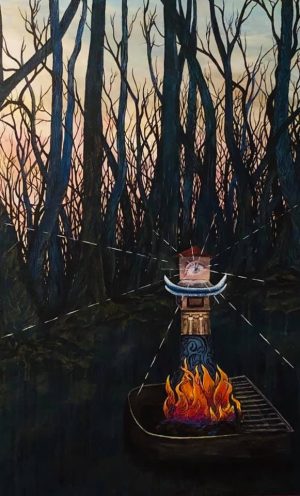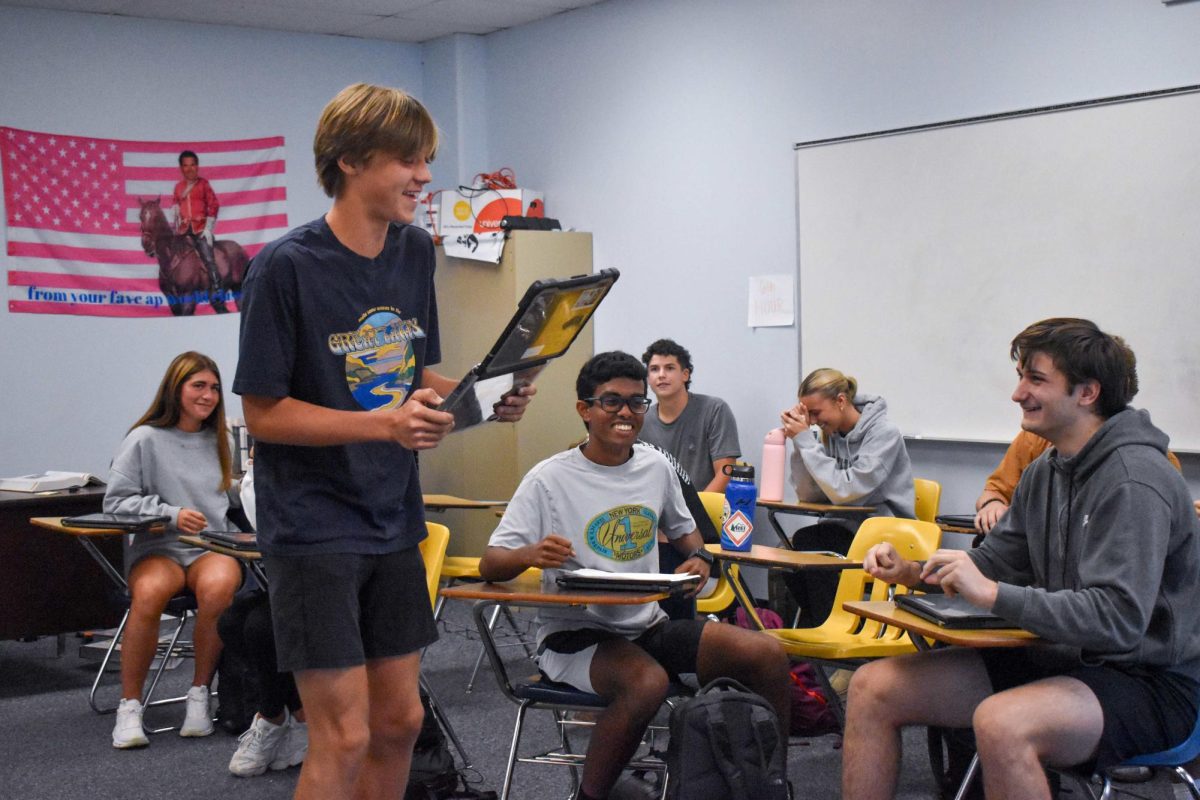
Rather than using expensive and brand new canvases from craft stores like Michaels or Hobby Lobby, Design Arts and Digital Design teacher Kristi Ponder uses a more sustainable option: thrifted canvases. Ponder has used this method for three years, and they have become her preference when looking for an environmental and economical option.¬Ý
Not only does thrifting canvases save her money and help with conservation, but it also saves space in her house for artwork and materials because she can reuse canvases. When Ponder runs out of canvases, she generally finds thrifted ones at Goodwill. She prefers Goodwill because it focuses on helping those in need.
“I just look for the [canvas] size that I need. Goodwill gets the money, which is a really good organization. They have an adult high school that they run free of charge for people with things that prevented them from graduating high school,” Ponder said.
Ponder also incorporates sustainability into her teaching, providing her students with reused materials like wood scraps, old wire coat hangers, magazines and old books. She uses these recycled materials in different projects, such as sculptures made from recycled items.
‚ÄúWith my virtual students ‚Äî because I’m [teaching] half-day virtual ‚Äî we have a whole project about using natural materials to create art. They have a week to go outside and explore, and I introduce them to a couple of different artists that do that, like Andy Goldsworthy. They are temporary sculptures that eventually will go away, but they haven’t hurt the environment by using those materials,‚Äù Ponder said.

For her projects, Ponder finds inspiration in her everyday life, often focusing on relationships.
‚ÄúThe current [project] I’m working on is about a couple of close relationships I have and how they lock themselves inside, don’t exercise and don’t explore the world. They’re just stuck with their phones, TVs and social media,‚Äù Ponder said. ‚ÄúI get inspiration [from] everything I see, everything I do and people in my life.‚Äù
To explore different uses of materials in her art, Ponder plans to attend a summer class at The Cleveland Institute of Art, a college in Ohio focused on art, design and entertainment, for a few weeks.
‚ÄúThe next [class] I’m taking is in Cleveland with ceramics. Because clay is all over the Earth, I‚Äôm trying to think about how I can use the clay. Buying from factories, the shipping and packaging pollute the environment, so [maybe] I could go out and get my clay.¬Ý Then, what can I use on top of the clay?‚Äù Ponder said. ‚ÄúI‚Äôm still learning.‚Äù
Ponder, who has bought fabric to make her canvases, is now looking to create materials from scratch.
‚ÄúI’ve experimented with different things, like making my yarn because I also crochet. Could I grow cotton, weave my yarn, crochet it into a canvas and then paint? It‚Äôs been in my head for a while, and I have all these ideas, but I don’t know if any of them will work,‚Äù Ponder said.
Although she has only implemented this new conservation method recently, environmental alternatives have connected Ponder more with her artwork.
‚Äú[Reusing materials] goes along with my beliefs about not being so wasteful and realizing that I’m not the center of the universe; I exist here with everybody else,‚Äù Ponder said. ‚ÄúWe all have to work together and take care of our environment. Otherwise, our future generations are going to have more and more issues.‚Äù


![Freshman Daphne Stokes looks at a table with Veterans Day flyers and information on Nov. 11. Stokes, along with other West High students, like senior Alexander Lewinski, passed by the table in the cafeteria with army recruitment information and giveaways for students to observe during lunch. “Talking with [the recruiters] has definitely helped me [find] where I wanted to go, more than anything else,” Lewinski said.](https://pwestpathfinder.com/wp-content/uploads/2025/11/DSC_1227-2-1200x800.jpg)
![Helping a customer, print room assistant Gretchen Williams operates her booth at the West High Craft Fair from Oct. 25-26. This was Williams’ first time participating in the Craft Fair with her new craft shop, Gs Beaded Boutique. “People have always said, over the years, ‘you should open something.’ [I replied that] I would rather just make [my crafts as] gifts for people. I just started [the online store] up, and it's been okay. I'm always surprised [by] how many views I get and [the] people from different states buying things; somebody from Alaska bought something the other day.”](https://pwestpathfinder.com/wp-content/uploads/2025/11/DSC0451-2-1200x799.jpg)
![Gesturing toward the club’s name on the board, Global Youth Aid co-president year Daniah Alsagheer discusses upcoming service projects with members during a meeting on Oct. 30. “We might be one club at one school, but together, we’re [part of] something much bigger,” Alsagheer said.](https://pwestpathfinder.com/wp-content/uploads/2025/11/DSC00949-1200x800.jpg)
![Focused on providing exceptional service, sophomore Darsh Mahapatra carefully cleans the door of a customer’s car. Mahapatra has always believed his customers deserve nothing less than the best. “[If] they’re trusting us with their car and our service, then I am convinced that they deserve our 100 percent effort and beyond,” Mahapatra said.](https://pwestpathfinder.com/wp-content/uploads/2025/10/DSC_0018-1200x800.jpg)
![Sophomore Aleix Pi de Cabanyes Navarro (left) finishes up a soccer game while junior Ava Muench (right) warms up for cross country practice. The two came to Parkway West High School as exchange students for the 2025-2026 school year. “The goal for the [exchange] program is to provide opportunities for both Parkway students and our international exchange students to learn about other cultures, build connections and become confident, capable, curious and caring — Parkway’s Four C’s — in the process,” Exchange Program Lead Lauren Farrelly said.](https://pwestpathfinder.com/wp-content/uploads/2025/10/Feature-Photo-1200x800.png)

![Gazing across the stage, sophomore Alexis Monteleone performs in the school theater. The Monteleone family’s band “Monte and the Machine” has been releasing music since 2012, but Alexis started her own solo career in 2024 with the release of her first single, Crying Skies. “My whole family is very musical, [and I especially] love writing [songs with them],” Monteleone said.](https://pwestpathfinder.com/wp-content/uploads/2025/09/DSC7463-1200x798.jpg)
![Amid teaching a lesson to her AP Calculus BC class, Kristin Judd jokes alongside her students in their funny remarks. Judd has always enjoyed keeping the mood light in her classroom, along with on the volleyball court. “[I enjoy] that side talk where you see [or] overhear a conversation and chime in, or somebody says something funny,” Judd said.](https://pwestpathfinder.com/wp-content/uploads/2025/09/image-1200x730.jpg)
![Eyeing the ball, junior Ella McNeal poses for her commitment pictures at Clemson University. McNeal’s commitment comes after months of contact with top Division 1 soccer programs. “ It has taken a lot to get to where I am, but I know that [what] I've already been through is just the beginning, and I can't wait for what is to come,” McNeal said.](https://pwestpathfinder.com/wp-content/uploads/2025/09/IMG_4926-1200x900.jpeg)